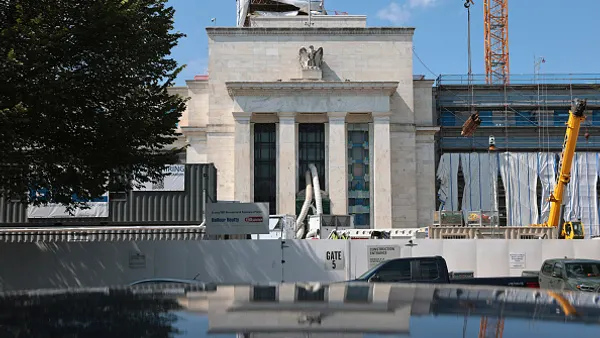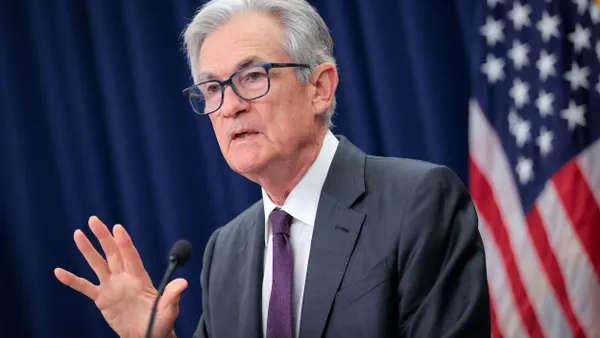After more than seven years, Wells Fargo has been freed from its growth constraint.
The Federal Reserve has lifted the asset cap that Wells Fargo has operated under since 2018, determining that the lender has met all conditions required for the growth restriction’s removal, according to a news release Tuesday.
The much-anticipated decision removes the “cloud,” the “stigma,” the “scarlet letter” that’s hovered over Wells for the past several years in the wake of the regulatory clampdown stemming from sales practice issues, analysts said.
The $1.95 trillion asset cap was tied to a 2018 enforcement action against the bank, “responding to widespread consumer abuses and compliance breakdowns.” The bank was ordered to improve its governance and risk management program in the wake of the lender’s 2016 fake-accounts scandal, in which the bank’s employees opened millions of fake customer accounts to meet sales targets.
The bank also had to obtain a third-party review of its improvements for the cap to be removed. Additionally, the Fed said it completed its own assessment of the bank’s corporate governance and firmwide risk management programs.
The San Francisco Fed, with the review of the director of the division of supervision and regulation, conducted numerous supervisory activities to assess the bank’s progress, said the order, dated May 30. Based on their recommendation, the Fed’s board determined the asset cap be removed.
“The removal of the growth restriction reflects the substantial progress the bank has made in addressing its deficiencies and that the bank has fulfilled the conditions required for removal of the growth restriction,” the Fed said in its release.
Still, “the other provisions in the 2018 enforcement action will remain in place until the bank satisfies the requirements for their termination,” the Fed said Tuesday.
That includes actions to ensure the bank’s financial and managerial resources serve as a source of strength to the bank. It also includes bolstering board effectiveness through stronger oversight of senior management and the bank’s risk and control framework, and detailed reporting on the bank’s efforts to comply with the consent order so it can evaluate the effectiveness of risk management functions.
Additionally, the bank was ordered to improve its risk management program and obtain third-party reviews of program enhancements, and the Fed noted it may direct the bank to conduct additional reviews. Wells’ board was also directed to submit quarterly progress reports to the San Francisco Fed.
The central bank’s board voted unanimously to lift the cap. Fed Gov. Michael Barr, who until recently was the central bank’s vice chair for supervision, issued his own statement accompanying the news, signaling continued watchfulness.
“Removal of the asset cap represents successful remediation to the required standard based on focused management leadership, strong board oversight, and strict supervision holding the firm accountable,” Barr said in the statement. “All three will need to continue for the firm to have a sustainable approach.”
Wells CEO Charlie Scharf said the decision “marks a pivotal milestone in our journey to transform Wells Fargo.”
“We are a different and far stronger company today because of the work we’ve done,” he said in a statement Tuesday. “In addition, we have changed and simplified our business mix, and we have transformed the management team and how we run the company. We have been methodically investing in the company’s future while improving our financial results and profile. We are excited to continue to move forward with plans to further increase returns and growth in a deliberate manner supported by the processes and cultural changes we have made.”
The bank’s board chair, Steven Black, noted “the substantial changes we have made to board composition and oversight,” and credited Scharf with his leadership in overseeing the transformation.
The bank will give all full-time employees of Wells Fargo a special $2,000 award as a demonstration of appreciation, Scharf said.
The bank’s situation “was exceptional because, after a series of truly egregious control failures epitomized by the fake accounts scandal, regulators concluded that the ‘culture’ of the bank was broken,” said Todd Baker, a senior fellow at Columbia University’s Richman Center for Business, Law and Public Policy. “It takes years for a bank to prove to regulators that something as amorphous as ‘culture’ is fixed.”
It’s been a costly period for Wells: While the lender has been unable to grow its balance sheet, peers such as Bank of America and PNC have grown their assets by around 40%, he noted.
“Despite this, Wells managed to post a competitive return on equity during the cap period by moving strategically towards less capital-intensive businesses,” Baker said. “Ironically, the restrictions have probably made Wells a better, and more efficient, bank.”
‘Victory!’ or an ‘outrageous giveaway’
Many speculated the cap’s removal had to be soon, given the pace of consent order closures by regulators this year. Last week’s termination of an Office of the Comptroller of the Currency consent order marked the seventh this year and the 13th since Scharf took the helm of the bank in 2019.
The Fed’s decision validates the work Wells has done under new management, Piper Sandler analyst Scott Siefers wrote in a Tuesday note. As for the consent order the cap is tied to, “it is only a matter of time until that, too, is discarded,” he added.
With the handcuffs now removed, some blasted regulators’ 2018 decision to restrict the bank’s growth in the first place.
“It is an absurd penalty, in our view, because by simply imposing a cap on assets – regardless of how risky they are or how they are generated – it of course induces the subject company to shed its lowest spread assets, which are of course also typically the lowest risk assets,” Oppenheimer Analyst Chris Kotowski wrote in a Wednesday note. “Think of corporate deposits parked at the Fed or a trading book of treasuries. Those are the kinds of things that need to be whittled down to make room for proper customer assets.”
To others – such as Sen. Elizabeth Warren, D-MA, the ranking member of the Senate Banking Committee – the cap’s removal prompted ire. “The Fed’s decision to lift Wells Fargo’s asset cap and declare victory despite overwhelming evidence to the contrary is an outrageous giveaway to one of Wall Street’s most derelict banks,” she said in a statement Tuesday. “The entire Federal Reserve Board, including appointees of both parties, should be embarrassed.”
She contended that the bank “has a long history of violating the law, and there’s no evidence that it has changed.” She cited the bank’s violations of anti-money laundering and financial crimes regulations, and whistleblowers who’ve warned the bank is bringing back old sales practices.
“It is stunning that the Fed couldn’t wait until the company went even a full year without breaking the law before wiping its slate clean,” Warren said.
The senator called on the central bank to share the lender’s exam reports for the last five years with the Senate Banking Committee.
What’s next?
Wells “can now operate on offense unfettered,” Siefers wrote. “At a minimum, it lifts a highly visible and company-specific cloud that has hung over the company for many years.”
During a conference appearance May 28 – just two days before the Fed order removing the cap was signed – Scharf sounded confident that the cap’s removal was closer than ever.
“Our level of confidence in terms of where we are and how far we are down that road is extremely high,” Scharf said. “We’re not done, but we’re a hell of a lot closer to the end than the beginning, at this point.”
After scrapping nearly everything the bank was doing to fuel growth in retail banking following the scandal and then rebuilding an appropriate infrastructure “to grow properly,” Wells is now chasing growth in its retail deposits business, Scharf said last week.
Growth there could fund expansion of other businesses. Scharf has also identified opportunities for Wells to further invest in its wealth business, to take in more commercial deposits and to be more aggressive in terms of lending once the cap is lifted.
“We expect the earnings profile of the company to change as trading and investment banking are likely to be key areas of growth,” JPMorgan analyst Vivek Juneja wrote in a Wednesday note.
Scharf said “there’s no light switch” on the bank’s growth following the cap’s removal. But “it does lift a cloud that exists” around the bank, both tangibly and in mindset, he said.
A “freer operational hand” should allow the bank to eventually revisit its current 15% return on tangible common equity target, “which many consider a way station rather than a destination,” Siefers wrote.
Analysts expect some cost savings from the bank’s regulatory and legal spending moderating to some degree. As Wells chases growth, though, maintaining its overhauled risk approach will be crucial for the bank, one analyst noted.
“What will be important for Wells is to manage risk and maintain controls tightly as it looks to expand trading revenues further, including in Financing,” Juneja wrote. “Wells is already the largest player in loans to non-bank financials.”
Siefers said he doesn’t expect management to stray from its more disciplined approach, and “leveraging its freedom will be a marathon rather than a sprint.”




















